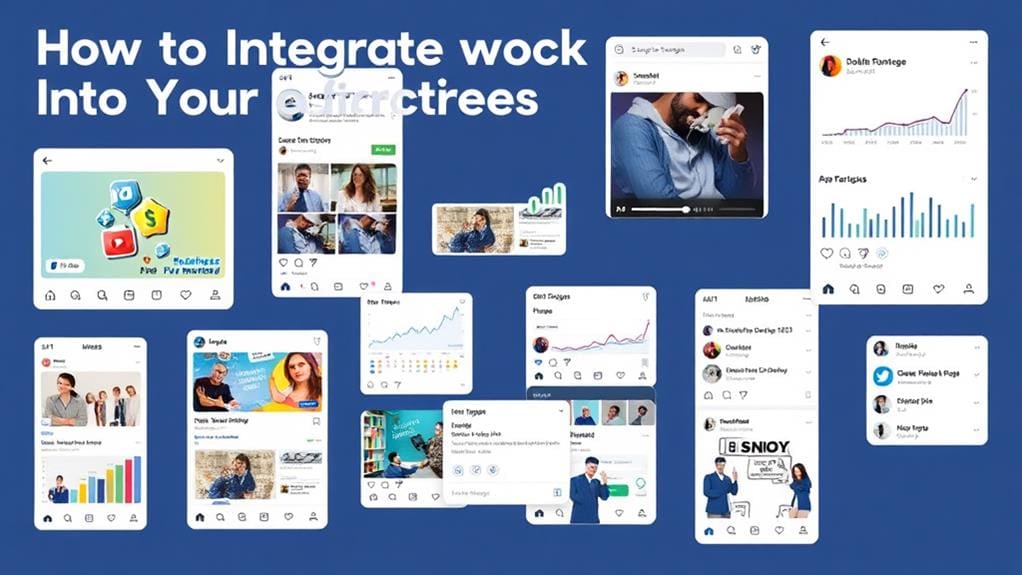How to Integrate Social Media Into Your Marketing Strategy
Integrating social media into your marketing strategy starts with defining clear, measurable goals aligned with your business objectives. Understanding your audience is essential; demographic insights show that 70% of millennials prefer brands that resonate with their values. Selecting the right platforms guarantees maximum engagement, while creating engaging, visually appealing content can increase shares considerably. Leverage influencer partnerships to broaden your reach and monitor metrics to refine your approach. Consistency and authenticity in your messaging enhance community trust. As new trends emerge, staying informed will further elevate your strategy and connect you with your target audience. Discover more insights ahead.
Key Takeaways
- Define clear, measurable goals that align with business objectives to enhance customer interactions and guide strategy adjustments.
- Understand your audience through segmentation, demographics, and evolving trends to create tailored and engaging marketing campaigns.
- Choose the right social media platforms based on audience preferences and platform features to maximize engagement and efficiency.
- Create engaging content using visual storytelling and interactive strategies that foster community and encourage two-way communication.
- Monitor metrics such as engagement rates and conversion rates to refine strategies and adapt to audience needs in real-time.
Define Your Goals

In today's fast-paced digital landscape, many businesses recognize the importance of having a clear set of goals when integrating social media into their marketing strategy. Goal alignment is essential; it guarantees that every social media effort resonates with your overall business objectives, fostering coherence in execution.
By establishing measurable objectives, companies can assess performance more effectively, adjusting strategies in real-time based on data-driven insights. Research shows that organizations adopting clear goals for social media engagement see a 30% increase in customer interactions. This statistic underscores the necessity of defining specific, quantitative objectives.
For instance, whether your aim is to enhance brand awareness, drive traffic to your website, or generate leads, each goal should be articulated in such a way that progress can be easily tracked. To set your measurable objectives, consider the SMART criteria—specific, measurable, achievable, relevant, and time-bound.
For example, rather than stating, "I want to grow followers on Instagram," shift to "I aim to increase our Instagram followers by 25% over the next three months." This clarity empowers your team, guaranteeing that everyone is aligned and focused on a common objective.
Moreover, by regularly reviewing these measurable objectives, businesses can remain adaptable, readily capturing trends to seize market opportunities. Freedom in strategic execution arises when goals are not just aspirational but also tangible, driving innovative thinking and creative solutions in social media marketing.
Define your goals artfully, and you lay the groundwork for impactful engagement.
Know Your Audience
Understanding your audience is the cornerstone of an effective social media marketing strategy. Knowing who your target audience is not just a strategy; it's an essential aspect of engaging in meaningful conversations that resonate.
Through meticulous audience segmentation, you can classify your potential customers based on common characteristics, behaviors, and preferences, leading to personalized content that truly speaks to them.
Demographic analysis is a powerful tool in this process. It allows you to break down your audience into categories such as age, gender, location, and income levels. For instance, a recent survey indicated that 70% of millennials prefer brands that show a genuine understanding of their lifestyle and values.
By leveraging this data, businesses can create tailored marketing campaigns that go beyond generic messaging.
Understanding your audience also involves keeping the pulse on evolving trends and market dynamics. For instance, if your product caters to health-conscious consumers, emphasizing sustainability and organic ingredients can be a compelling approach.
Engage your audience by innovating within these trends, generating content that encourages dialogue, and fosters community.
Choose the Right Platforms

Selecting the right social media platforms is essential for maximizing engagement and achieving business goals.
By understanding your audience's preferences, evaluating the unique features of each platform, and analyzing current industry trends, you can tailor your marketing strategy effectively.
This strategic alignment not only enhances brand visibility but also fosters genuine connections with your target demographic.
Know Your Audience
To effectively engage audiences, marketers must strategically choose the right social media platforms that resonate with their target demographics. This process begins with thorough audience segmentation and demographic analysis, enabling brands to pinpoint where their potential customers congregate online.
For instance, if your analysis reveals a youthful audience keen on visual content, platforms like Instagram and TikTok may be prime targets. Conversely, a more professional demographic might favor LinkedIn for their social interactions.
In today's data-driven landscape, understanding your audience is not just about identifying preferences; it's also about keeping up with evolving trends. For example, recent studies show that Gen Z engages more on TikTok than Facebook, suggesting a shift that some brands have yet to embrace.
Investing in proper audience analysis allows marketers to allocate resources more efficiently, reducing wasted efforts on platforms that do not yield results.
With multiple social media avenues available, the key lies in aligning your marketing objectives with the preferences of your audience. Freedom in expression and choice is essential for consumers; as a result, acknowledging their online spaces helps marketers craft targeted messages that resonate and inspire action.
Assess Platform Features
With a clear grasp of your audience's preferences and demographics, the next step is to assess the unique features of various social media platforms. Conducting thorough platform comparisons is critical to identifying which networks align with your marketing goals.
Each platform provides distinct advantages; for instance, Instagram excels in visual storytelling, while LinkedIn is the go-to for professional networking and B2B relationships.
When evaluating feature benefits, consider tools for analytics, engagement methods, and ad targeting capabilities. For example, Facebook's advanced targeting options allow marketers to reach specific audiences based on behaviors and interests, which can greatly enhance campaign effectiveness.
Conversely, TikTok is thriving on its algorithm-driven exposure that offers an organic reach potential, particularly attractive for brands wanting to connect creatively with younger demographics.
Further, consider the varying content formats available, such as live videos, stories, or polls. These elements can foster real-time engagement and community-building.
Ultimately, integrating social media requires a strategic focus on platform capabilities and features that will resonate with your audience while amplifying brand visibility and interaction. Choose wisely to harness the power of freedom in your marketing endeavors.
Analyze Industry Trends
In light of shifting consumer behaviors and emerging technologies, analyzing industry trends is essential for choosing the right social media platforms that align with your marketing objectives.
By leveraging trend forecasting and conducting a thorough competitive analysis, businesses can identify which channels resonate most with their target audience. Here are three critical steps to evaluate:
- Identify Consumer Preferences: Track which platforms are gaining traction within your industry. For example, data shows younger demographics are increasingly drawn to platforms like TikTok and Instagram, while older generations prefer Facebook.
- Analyze Competitor Activity: Observe your competitors' engagement metrics and content strategies. Their successes and failures can provide valuable insights into what may work for your brand.
- Stay Ahead with Trend Forecasting: Utilize tools and reports to anticipate shifts in social media use. Understanding where your industry is heading can provide an edge in selecting platforms before they become saturated.
Create Engaging Content
Creating engaging content is essential for capturing audience attention in today's competitive social media landscape.
Leveraging visual storytelling techniques, fostering interactive audience engagement, and maintaining a consistent brand voice can greatly enhance your content's effectiveness and shareability.
As consumer preferences evolve, brands that prioritize these elements are more likely to build lasting connections and drive engagement.
Visual Storytelling Techniques
Leveraging visual storytelling techniques has become essential for brands seeking to captivate their audiences in a saturated digital landscape.
Visual narratives not only engage viewers but also foster an emotional connection that can profoundly influence their purchasing decisions.
Here are three key techniques to enhance your visual storytelling:
1. Compelling Imagery: Use high-quality images that reflect your brand's values and resonate with your audience.
Research shows that posts featuring compelling visuals receive 94% more views than text-only content.
2. Video Content: Incorporate short, engaging videos into your strategy.
According to recent statistics, video content drives a 1200% increase in shares compared to text and image content combined.
3. User-Generated Content: Encourage your community to share their experiences with your products.
This not only builds trust but also creates authentic visual narratives that resonate on a deeper level.
Interactive Audience Engagement
Interactive audience engagement has emerged as a pivotal strategy in modern marketing, transforming passive viewers into active participants. This shift is essential as studies reveal that brands employing engagement strategies see up to a 70% increase in customer satisfaction.
Implementing tactics such as live Q&A sessions not only fosters real-time interaction but also personalizes the consumer experience, enhancing loyalty and trust.
Moreover, interactive polls have become a favorite tool among brands looking to gather insights while making audiences feel heard. With a click, consumers can express their opinions, influencing content and product decisions, which in turn cultivates a sense of ownership over the brand.
Recent trends indicate that 80% of consumers prefer to engage with brands that offer opportunities for participation, underscoring the need for businesses to adapt.
By harnessing the power of audience interactions, brands can create dynamic communities that thrive on feedback and meaningful dialogue. Embracing this two-way communication not only boosts visibility but establishes a vibrant ecosystem that resonates with the core desires of freedom and expression sought by today's consumers.
Ultimately, elevating engagement transforms your marketing strategy into a collaborative journey, rather than a mere broadcast.
Consistent Brand Voice
A consistent brand voice is crucial for effective communication, with over 60% of consumers reporting that they feel more connected to brands that maintain a cohesive tone across platforms.
This tone consistency enhances audience perception and fosters a deeper emotional resonance, key elements in today's fast-moving digital landscape.
To establish an impactful and adaptable brand personality, consider focusing on the following:
- Messaging Alignment: Confirm that all content reflects the same core values and objectives to enhance content uniformity across diverse channels.
- Voice Adaptability: While consistency is essential, it's also necessary to adapt your voice slightly based on platform dynamics. This flexibility can help maintain audience engagement without sacrificing brand integrity.
- Strategic Communication: Implement a well-defined communication strategy that outlines how your brand personality should shine through every post, tweet, and story.
Leverage Influencer Partnerships

Influencer partnerships have emerged as a powerful tool for brands seeking to enhance their marketing strategies amidst the ever-evolving social media landscape. By engaging in targeted influencer outreach, brands can create authentic connections with diverse audiences. These connections are strengthened through partnership agreements that clearly outline goals and expectations, promoting trust building from the outset.
A focus on content co-creation allows brands and influencers to present offerings in a way that resonates with their followers, showcasing genuine brand alignment. This collaborative approach not only enhances engagement but also guarantees the messaging retains audience authenticity, a critical factor in today's market where consumers demand relatable content.
Niche influencers are particularly valuable in this strategy. Unlike broad-market influencers, they cater to specific interests, providing brands with the opportunity to engage with highly targeted segments. Long-term collaborations with these influencers can amplify trust, as followers tend to identify them as credible sources within their specific domains.
Moreover, performance tracking is essential in evaluating the efficacy of these partnerships. Brands should prioritize engagement metrics such as likes, shares, and comments to gauge the responsiveness of audiences toward influencer content. This data-driven approach enables brands to make informed decisions, refine their strategies, and optimize future influencer collaborations.
Incorporating influencer partnerships into your marketing strategy not only leverages the reach of key opinion leaders but also fosters a dynamic connection with consumers that is both authentic and engaging.
Monitor and Analyze Metrics
Evaluating the success of influencer partnerships is only the beginning of a thorough marketing strategy; brands must also continuously monitor and analyze engagement metrics to fully understand the dynamics of their social media presence.
Implementing effective metric tracking allows companies to assess their influence and adapt their strategies in real-time.
To guarantee your brand is on the right track, focus on these three key areas for performance benchmarking:
- Engagement Rate: This is a measure of how well your audience interacts with your content. A high engagement rate indicates that your messaging resonates. Track likes, comments, and shares to see what's working.
- Conversion Rate: Understanding how social media traffic translates into actual sales or leads is essential. Use UTM parameters to attribute visitors from social platforms to specific actions on your website.
- Audience Growth Rate: Monitor how quickly your following is expanding. A steady increase signifies that your social strategy is drawing in new users, while stagnation may signal a need for fresh content.
Utilize Paid Advertising

Paid advertising has become a cornerstone of effective social media marketing strategies, enabling brands to reach targeted audiences with precision. With over 4.5 billion social media users globally, leveraging paid advertising allows businesses to tap into this vast pool, ensuring their messages reach the right eyes at the right time.
The key to successful paid advertising lies in target audience segmentation. By understanding the demographics, interests, and behaviors of potential customers, brands can craft tailored ad campaigns that resonate deeply with specific groups. For instance, utilizing tools provided by platforms like Facebook, Instagram, and LinkedIn allows marketers to create audience segments based on various criteria, ensuring ideal ad placement that aligns with users' needs and preferences.
Moreover, ad performance optimization is essential in maximizing returns on investment. Continually analyzing ad metrics—such as click-through rates, conversion rates, and engagement levels—enables marketers to refine their strategies. Tools such as A/B testing allow for real-time adjustments, ensuring that ads are not only attracting views but also driving actionable results.
In a landscape where consumer preferences are ever-evolving, the flexibility of paid advertising empowers brands to pivot strategies quickly. This freedom to experiment and innovate in real-time positions businesses to stay ahead in their marketing objectives.
Consequently, embracing paid advertising in social media not only enhances reach but fosters deeper connections with your audience, creating an impactful online presence that goes beyond mere transactions.
Encourage User-Generated Content
User-generated content (UGC) has emerged as a powerful tool within the domain of social media marketing, offering brands an authentic way to engage with their audience. By encouraging customers to share their experiences and creations, companies can foster a sense of community and trust that is invaluable in today's fast-paced digital landscape.
UGC not only amplifies brand messaging but also enables customers to be seen and heard, promoting a sense of freedom in their expression.
Here are three effective strategies to encourage user-generated content:
- Content Contests: Organize competitions where customers can submit their own content related to your brand. For example, a photography contest featuring your products can generate compelling visuals and engage your audience.
- Community Challenges: Create challenges that motivate users to participate in a common goal, such as a fitness journey or a sustainability initiative. This brings people together and can be a source of continuous interaction and content creation.
- Hashtag Campaigns: Develop a unique branded hashtag that users can include when sharing their posts. This not only aggregates UGC but also makes it easier for your audience to discover and connect with others in the community.
Through these strategies, brands can tap into the creativity of their customers, driving engagement and building a loyal following.
Embracing UGC not only enriches your content landscape but also champions the voice of your audience.
Stay Consistent and Authentic

A cohesive social media marketing strategy hinges on the principles of consistency and authenticity. During a time when consumers crave genuine connections, maintaining a steady brand voice across platforms is paramount. Data shows that brands with consistent messaging and visuals across channels see a 23% increase in customer engagement. This is indicative of the growing demand for transparency and reliability.
To achieve this, implement content scheduling tools that facilitate regular posts, ensuring your brand remains top of mind without overwhelming your audience. Scheduling not only frees up time but also allows for strategic planning—ensuring you share relevant content aligned with current trends and conversations.
Moreover, brand authenticity goes beyond simply being present; it demands that your messaging resonates with your audience's values. Authenticity fosters trust, a significant commodity in today's market. A recent survey revealed that 86% of consumers believe that transparency from brands is fundamental to their choice of loyalty.
By sharing behind-the-scenes content, personal stories, or user-generated experiences, you reinforce your brand's narrative while inviting your audience to engage with your journey. This reciprocal relationship nurtures a community feeling, allowing consumers to see themselves within your brand's story.
Ultimately, balancing consistency with authenticity in your social media strategy not only helps establish a dependable presence but also transforms your brand into a relatable entity—a critical step towards fostering long-lasting customer relationships.
Frequently Asked Questions
How Do I Manage Negative Comments on Social Media?
Managing negative comments on social media requires effective responding strategies and diligent comment moderation. Engage with negative feedback promptly to demonstrate transparency and attentiveness.
Address concerns constructively, providing solutions when possible, and redirect conversations to private channels if necessary. Analyzing recent trends in audience sentiment can provide insights on common issues, enabling proactive communication.
Ultimately, fostering a culture of open dialogue encourages freedom of expression while maintaining a positive brand image amidst criticism.
What Budget Should I Allocate for Social Media Marketing?
How can one determine the ideal budget for effective social media marketing?
Start by evaluating your target audience and the specific content types you plan to use.
Consider industry benchmarks, which suggest allocating 5-10% of your overall budget to social media efforts.
Analyze trends in engagement and conversion rates to adjust your investment strategically.
Ultimately, reallocating funds based on performance guarantees that you maintain the freedom to adapt and grow.
How Often Should I Post on Social Media?
Determining the ideal posting frequency on social media is critical for maximizing audience engagement. Current trends suggest that posting several times a week can enhance visibility and interaction.
However, the best frequency varies by platform and audience preferences. For example, brands on Instagram may benefit from daily posts, while those on LinkedIn might find a few times a week suffice.
Analyzing engagement metrics can provide insights to refine your posting schedule effectively.
What Tools Can Help Schedule My Social Media Posts?
Maneuvering the vast ocean of social media requires tools as reliable as your favorite lighthouse.
Effective post scheduling can be achieved through platforms like Buffer, Hootsuite, and Later, which enable the creation of a content calendar that guarantees consistency and reaches target audiences at ideal times.
These innovative solutions empower marketers to maintain an organized digital presence, fostering engagement and allowing creative freedom while minimizing the stress of frequent posting.
How Can I Measure Social Media ROI Effectively?
Effectively measuring social media ROI requires a focus on conversion tracking and engagement metrics. By implementing conversion tracking tools, businesses can identify which social media activities lead to meaningful actions, such as purchases or sign-ups.
Simultaneously, analyzing engagement metrics, including likes, shares, and comments, provides insight into audience interaction and content performance.
Combining these data points allows for a thorough understanding of social media impact, facilitating informed decisions that optimize marketing efforts and drive growth.
Conclusion
The successful integration of social media into a marketing strategy demands diligent discovery and deliberate decision-making. By defining distinct goals, discerning the target audience, and selecting suitable platforms, brands can craft enthralling content that resonates. Establishing influencer partnerships and encouraging user-generated contributions amplify visibility, while consistent monitoring of metrics guarantees strategic success. Ultimately, a harmonious blend of authenticity and innovation paves the path to persuasive online presence, driving dynamic engagement and delivering meaningful results.




